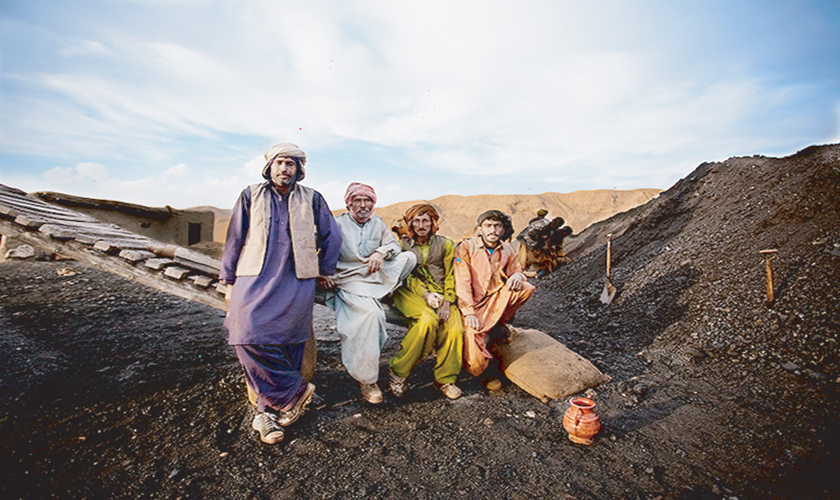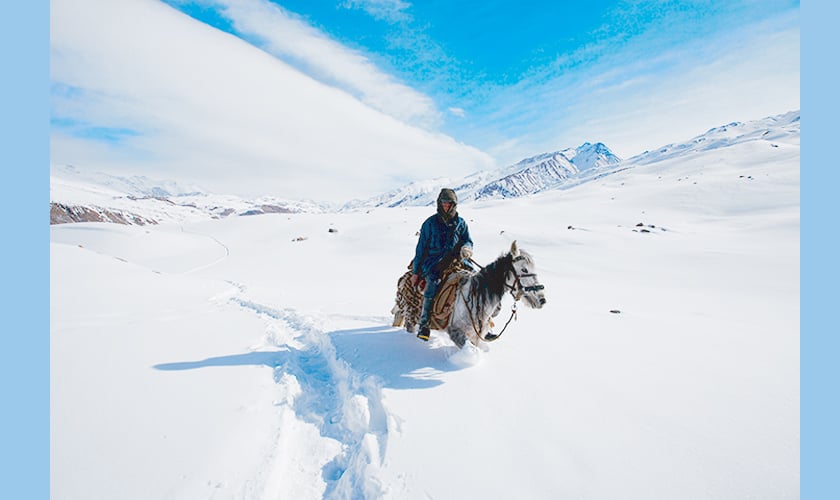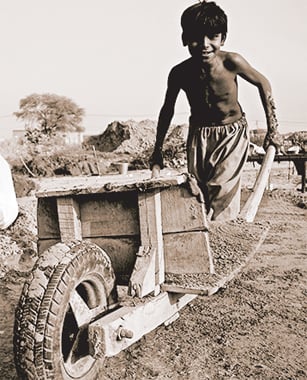We like to think ourselves as “progressive”, but we are still very much tied to and restricted by our traditions, or rather our understanding of them.
Some fresh angle, some new shots
We like to think ourselves as “progressive”, but we are still very much tied to and restricted by our traditions, or rather our understanding of them.

So, if a 32-year-old stands up from our midst and initiates the first international photography festival in Pakistan which  would showcase works of national and international photographers, in what he hopes would enable cross-exchange dialogue, what do we have to say about it?
would showcase works of national and international photographers, in what he hopes would enable cross-exchange dialogue, what do we have to say about it?
Was he merely lucky to have a twin brother who got into MBA programme, giving him a chance to follow his dreams without worrying about a 9-5 job after studies? Because that’s what we’re supposed to do, right? Boys even. Get a degree, find a paying job, get married and settled. Was it his family, his father especially, who supported him no-matter-what: “It’s your life. Make your own decision; take responsibility of it and learn from it. Don’t come to me, blaming that XYZ was my fault.”? Hamaray abba tou 10 rishtedaaron se mashwarein lein hamaray career kay baray mein. Or was it simply the determination of Shah Zaman Baloch, Founder and Festival Director, that a year later of having been announced, Pakistan Photo Festival (PPF) found just the 15 individuals for its preliminary programme?
From promoting photography as a serious art form in Pakistan to conveying the story of Pakistan through the lens of its own people, unadulterated, the Skype session covered everything.

Us: Tell us about the two-month fellowship that commenced from March 13.
Shah Zaman Baloch (SZB): I’m a globe-trotter. I’ve spent a lot of time in Europe and I’ve been attracted to photo festivals that are held in almost every major city in the region. In parts of South Asia, too! There’s India, Bangladesh, Nepal. And since I’m part of this field, often they’d invite me; others, I’d just drop in and see what they had to offer.
When we consider Pakistan, almost everyone nowadays claim to be a photographer. Yet, no photo festival has ever been organized in the country. That’s why I thought I should announce one. But I had to plan everything from the scratch.
The first aspect was submissions. I could’ve either asked people to send in their submissions or I could’ve asked foreigners to send in their portfolios to put on display here. The first would have meant hoards of pictures of Nathia Gali and Hunza and portraits of elderly women, given the type of photography that’s found extensively on social media; the second would have that “outsider’s” perspective attached to it. In other words, both of these approaches would amount to nothing. They wouldn’t create any dialogue within the society. Yes, people would have come, enjoyed the beautiful images, and left. They wouldn’t have carried forward with them a message and they’d likely forget all about the lakes and mountains the minute the exhibition would have been over.

My concept was not to show the part of Pakistan that you can Google. I wanted a festival which could encourage dialogue and for that purpose, I sought to include documentary photography. For that, I needed photojournalists who’d take responsibility, actually go out and document. Photojournalism doesn’t necessarily mean you have to work on social ills every time. There are so many things you can cherish, too. That’s why the festival focuses more on photojournalism and documentary photography.
Now the problem is, these fields respectively are practically non-existent in our country. It’s so easy now for our new generation to learn. But what they have in technology, they lack in inspiration; they only have wedding photographers or product photographers or travel photographers to follow. There are zero inspirational figures locally for them to aspire to, someone who could teach them to document their present time. That’s why we don’t have a bigger collection of Pakistan’s history in photographs! There are only a limited number of pictures which were again taken by foreigners. This is essentially PPF’s main objective: to bring our young generation towards documentary photography, assigning them issue-based multi-media projects to highlight social, legal, economic, etc. struggles in the country.
For starters, we did not charge any submission fee nor is there any age limit. Every year, we will select 15 photographers, train them in documentary photography and photojournalism and ask them to produce a body of work. Internationally-recognized photographers will supervise them and mentor them throughout the different stages - research, design, execution and production. So instead of following the general pattern and exhibiting the work of foreigners year after year, I chose to make the work of these 15 photographers the centre of PPF besides including stories from other countries/international platforms. This way, PPF will be the first of its kind.
Us: Tell us about your team?
SZB: I’d like to mention here that I don’t have any funding from anybody. Those who wanted to sponsor my show wanted it to be a typical (commercialized) one, which I knew wouldn’t create the desired impact. I don’t want people to come and see another image of a rose flower or a sunset or of Minar-e-Pakistan with perhaps a different angle than they’ve already seen online thousands of time. I want them to learn about their own society, the good and the bad both. I took a stand to not let anyone influence my vision of PPF. Secondly, there is no collaboration within the photographer’s community; it’s impossible to think of, let alone find, a good support system here.
The conflict of interests means I didn’t have that many people at my disposal. So, I’d like to give a shout out to the following members of my team who’ve helped me overcome setbacks and helped me come this far in achieving my goal. There’s Iram Sana, festival coordinator; Midhat Abbas, USA festival coordinator; and Farwa Batool, communication designer.
For mentoring, we have Asim Rafiqui (Lahore, Pakistan), Matthieu Paley (Paris, France), Wendy Marijnissen (Antwerp, Belgium), Mahesh Shantaram (Bangalore, India) and Didier Ruef (Lugano, Switzerland).
Us: As opposed to the common misconception, where do you draw a line between a photojournalist and a photographer?
SZB: There are very few people who are actually photojournalists. We have more press photography in our country wherein journalists go to an event and capture images that would best convey the story. Unfortunately, these two terms are often used interchangeably. Photojournalism denotes independent photographers - or photographers who are affiliated with some news agency/news channel/newspapers - who research a subject, work on it, interact with it, take pictures and only then come up with a body of work which they publish along with their write-ups. And when you see it that way, we realize that this kind of trend does not exist in Pakistan.
Us: How did you break into the photography world and advance to where you are today?
SZB: I’m a filmmaker basically. I did my graduation from National College of Arts (NCA) in Film and TV back in 2008. I was part of the first batch of Pakistan. But I’ve been interested in photography since forever. And I started exploring it more, taking photographs of buildings and landscapes initially and street photography later on; went on to writing a few stories, including coverage of the lives of coalminers in Balochistan.
Photography, for me, is something that I don’t want to do commercially. Now that I don’t work for any proper organization, there’s no “typical day” sort of thing in my career. Say if I were affiliated with anyone, there would have been certain work requirements, some assignments that I would have to follow and/or do on a daily basis. It’s a completely different story when you are working on your own, as a travel photographer, as a documentary photographer. I don’t take photos every day. I write about some issue that I relate with and not just because any organization wants me to work on it. It’s probably the best thing - travelling, making new friends. While I can go everywhere, it comes with a cost - I don’t get enough time to spend with my family.
Us: Your work has been appreciated worldwide and you have accolades to your name. Having served in the capacity of a short-film director, cinematographer, writer, editor and photographer, is there anything you know now that you wish you knew before?
SZB: An individual’s approach towards his or her profession tends to change with time. However, I knew photography is a visual medium. Plus, I always wanted to travel, but not as a profession. So I had some idea what this field would be like.
I remember when I applied to Sindh University (before NCA announced their course). You have all these choices when filling the admission forms of public universities and students usually mention the “best” subjects (Business, etc.) and keep Fine Arts as a last resort. When I mentioned Fine Arts as my one and only option, I got strange looks from the clerk receiving it. He thought I was bonkers. I had to explain to him my passion for visuals. I used to sit alone and observe the small details of nature. From the beginning, I knew that I was not a kitaabi guy. I started learning about film - and eventually cinematography and photography - after I got admission in NCA.
Further, people think that you can only be a professional photographer if you have big, expensive gadgets. I’ve seen poor shots taken with expensive equipment, and trust me when I say a decent, small, good camera can fill the bill just as perfectly. I use very ordinary lenses along with a very ordinary camera; in fact, I’ve started shooting with mobile phone recently. They, however, assume that I want to keep it all hush-hush. Why would I do that? But, I know how people judge someone based on the clothes they’re wearing or the car they’re driving and I know we can’t really blame them for thinking along the same line for photography cameras as well.
Us: What is the scope of photojournalism in Pakistan in your opinion?
SZB: While there are many universities across the world that allow you to have a diploma or get a degree in photography course, it is available only as a minor in Pakistan. One of the goals of PPF is to educate people to seriously think about photography in terms of academics. When this medium is given due importance at educational institutes, then some serious work will be produced, too.
An advice for those applying abroad is to work more on stories. When universities are going through your portfolios, they are less likely to be impressed by the quality of the picture than they are going to be if the subject has some background story to it.

Unless you want to be associated with any magazine or other publishing medium, earn through fashion/product/wedding photography shoots, there is no job market in Pakistan for photographers. And if these areas suit you, then honestly, you don’t even need to obtain a degree from a foreign university for it.
At PPF, we’ll be encouraging the photographers to retain their individuality; not prepping them for a job where their work is bound to be influenced by the channel or organization’s policy. We are trying to develop a whole new industry. We’ll be maintaining a database of the photographers attending PPF every year and the photographic work they do in such manner that if New York Times wants a story, they should be able to contact a Paksitani photographer who’s trained in photojournalism and documentary photography for the assignment as compared to sending one of their own to cover it.
Us: Favourite project?
SZB:Around two or three years ago, I visited this place in the Chitral district. People usually prefer to go there in summer; even then they face difficulty. I wanted to experience that in winters. So I walked for eight days alone in the mountain to reach that place. I met the Wakhi people living on the border, and took their permission to spend time with them during the season. Funny thing is I wasn’t assigned this by someone. I didn’t endure -25° temperatures, because someone asked me to. The whole place was covered with snow and there was no vegetation point after a certain point. I liked that experience; it was one of my favourite projects.
Us: Tips for beginners?
SZB: Never take a picture of or observe without getting explicit permission from your subject. Explain your project to them and ask them to sign the release form. This is specifically for commercial stuff (images that you are selling, for instance uploading it to Getty images); for editorials (stories that you are publishing for sake of awareness) don’t require one. What I like about documentary photography is that it’s all evidence-based so there’s no exploitation, exaggeration, coming up with fake news type of drama. Go spend time in society, interact and document issues at the grassroots level.
Photo courtesy: Shah Zaman Baloch